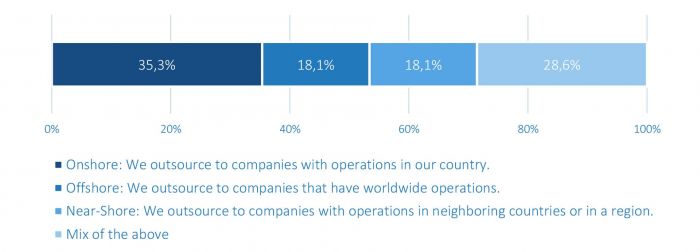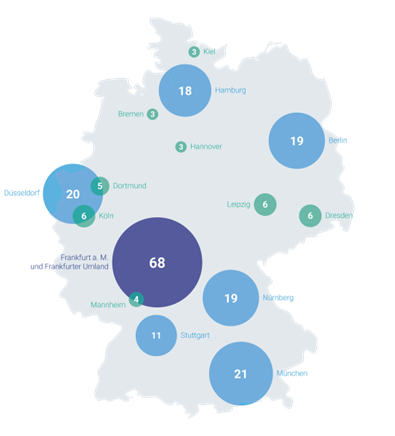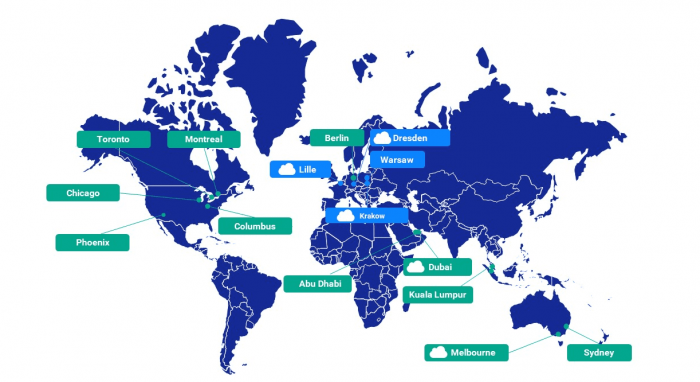What You Need to Know About Data Center Locations

They are among the most important building blocks of digitization – without data centers, there would be no Netflix, Google, or Amazon, let alone Artificial Intelligence, Cloud Computing, or the Internet of Things. All of that requires a solid, secure, high-performance IT infrastructure. A good thing then, that data centers are numerous and located all over the world. The data center market is growing, despite facing new capacity, competition and carbon challenges. What is more, according to the Data Center Cost Index 2021 by Turner & Townsend, 70% of data center providers consider this industry to be recession-proof. Read on to learn which criteria are particularly worth considering when choosing a data center location.
A 2021 Synergy Research Group report found that overall spending on data centers globally grew by roughly 10% in year-on-year terms, reaching a total of $185 billion in 2021. The lion’s share of that spending was on hardware, with 77% of the total spend going towards servers, storage and networking gear. Those investments are shifting more and more in a different direction though. While organizations of trade, industry, and science used to operate their own data centers, the last few decades have seen an ever-increasing trend towards data center outsourcing. This encompasses data center services and cloud services provided via secure Internet connections. What has led to this situation?
Data Center Outsourcing: Onshoring, Nearshoring, and Offshoring
High electricity prices and a general skill shortage are but two of many reasons why companies switch to external providers instead of operating servers and other hardware resources on their own premises. However, providers too are affected by those problems. And, although Scandinavia is scoring higher compared to the rest of Europe thanks to low electricity costs, skill shortage remains a Europe-wide problem that has experts predicting Asia as the most important provider of IT-outsourcing services.
Offshoring – Definition, Challenges, and Benefits
Offshore refers to IT-outsourcing to far-away countries with considerable time zone differences. There are some challenges related to that. The farther away a provider is geographically, the bigger might be the cultural and especially the legal differences. The good thing about offshoring is that it is cheaper, at least at first glance.
Advantages of Onshoring and Nearshoring
On the other hand, a closer look at onshoring (outsourcing to service providers located in the same country) and nearshoring (outsourcing to countries located in close proximity with similar time zones) will often reveal essential operational advantages. With the developments of recent years having flooded the market with countless providers of data center services even before the pandemic, companies are now more than ever spoilt for choice. It’s a choice with much to consider, especially regarding the implementation of GDPR. Where will data be kept, for example? Are all processes GDPR-compliant? How about the quality of the hardware deployed? Does the provider have all the necessary certifications? Another important question, particularly in light of the new supply chain law, is whether the provider fulfills all the major standards concerning environmental protection and occupational health and safety.
So, how to choose a Data Center Location?
All those things are easier to verify and monitor if the provider is located relatively nearby. So, what if the data center provider is subject to EU law, possibly even the national law of their client‘s country of operation, or if they are based only a few streets away in the same town? That would make everything easier, from communication, through organization, to operation.
Impact of Schrems II and the CLOUD Act on Data Center Location
With many digital services being offered by US tech giants such as Amazon, Google, and Microsoft, the US is probably the highest-ranking nation in the world when it comes to technology. Billions of people use those cloud services on a daily basis without giving it much thought. In terms of data protection and privacy, however, the differences between the US and Europe could hardly be starker.
EU-US Data Transfer – Safety Measures
With its Schrems II ruling, the European Court of Justice made plain that the personal data of EU citizens may only be transmitted to third countries where equivalent data protection is in place. The court also decided that that is not the case in the US. According to a comment published on the website (available in German) of Germany‘s Federal Commissioner for Data Protection and Freedom of Information, additional measures must be taken whenever personal data is transferred to the US or, if necessary, to other third countries, in order to ensure that there too the data are adequately protected at all times.
Laws such as the USA PATRIOT Act and the 2018 CLOUD Act (Clarifying Lawful Overseas Use of Data) have only added to the problem. Subsidiaries of US companies with locations abroad are obliged to grant US authorities access to their servers, even if that violates the laws of the country in question. In such cases, where US law and EU regulations collide, European companies can quickly find themselves in a dilemma.
Privacy and GDPR Compliance – Where the Worlds Collide
Since GDPR was introduced, it has been essential for data center customers to create absolute transparency and to set up contracts with their cloud providers regulating, for example, which data are kept where, how to prove the whereabouts of data, and how to delete data at the request of data subjects. The GDPR only allows the processing and management of personal data in a way and to an extent that is compatible with the initial purpose for which it was collected. Moreover, access to personal data may only be granted to the persons responsible for effecting that purpose. Those are only two of several provisions that clash with the rules laid down in the US CLOUD Act.
Moreover, changes to personal data are to be logged, as is the passing on of personal data (for example, exporting from CRM over ERP systems), which is also subject to limitations. The rights of the data subjects to access their data and to have information deleted must be ensured as well. The term "personal data" refers to any information relating to an identified or identifiable natural person. The above applies to all companies within the legal territory of the EU, even those with fewer than 250 employees.
Data Center Outsourcing: Onshoring as the Most Popular Model
In a survey conducted among 130 Western European companies, 35% said they were outsourcing IT services to a provider who operates in the same country as them. Only 18% were nearshoring in neighboring countries or offshoring to providers who operate globally. Twenty-eight per cent of the companies questioned were using a combination of different outsourcing models. All in all, however, most companies clearly prefer outsourcing within their own country.

Germany as an Example of Distributing Data Center Locations
Let’s take a look at Germany. The map below shows the distribution of data centers in based on information from Rechenzentrum and Eco.de. The area with the highest concentration of data centers in Germany is Frankfurt am Main. The region harbors more than a quarter of Germany‘s total data center capacities in terms of surface area. Hosting in and around one region, Frankfurt am Main, has its advantages and disadvantages. On the plus side, the choice of providers is wide and many of their networks are joined here in the world's biggest Internet exchange point. What is less beneficial are the geohazards in the region, which can cause power outages for example. And with so many data centers located in one place, power limitations are to be expected as well.

According to DataCenterMap.com, the primary markets in Western Europe are related to the locations of the financial markets, and hence the highest density of colocation data centers is found in cities such as the previously mentioned Frankfurt (Germany), London (United Kingdom) , Amsterdam (The Netherlands) and Paris (France). Most of the internet traffic being exchanged in Europe is also being exchanged at the primary internet exchanges in these cities (DE-CIX, AMS-IX and LINX for example). Thus, the same issues we characterized above apply to the majority of European data center locations.
Achieving Geo-redundancy by Using Various Data Center Locations
Ideally, companies should use several different data center locations in order to achieve geo‑redundancy and significantly increase safeguards against failure. Comarch, for example, operates several data centers across Germany and Europe, as the map below illustrates:

It is also highly recommended to choose an experienced IT partner that supports its clients long-term and in every aspect of digitization. For example, Comarch renders data center services in one facility and can offer additional storage in other data centers, should the need arise – be it in Germany, another EU country, or across the globe. If you’d like to learn more about our data centers' location, please click here.
Summary – is the biggest Data Center Provider always the best?
While deciding on a data center provider, you should consider all of the elements in this article. It is good to search for a well-developed and reliable provider, although choosing the biggest one is not always the best scenario. There are smaller companies that have data center locations all over the globe to provide nearshoring and cloud services, but what differentiates them among bigger competition is that their services are more personalized and customizable – and they offer an IT partnership rather than just services. Comarch is among them, providing IT services for numerous well-known brands which appreciate its certified security measures and individual approach. If you’re interested in knowing more about our data centers and the opportunities they create for you, visit our ICT website.
Author: Bartlomiej Kluska, ICT Consulting Director, Comarch